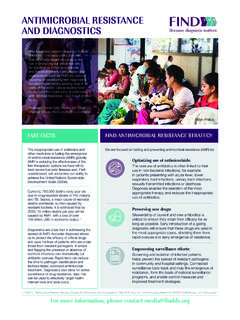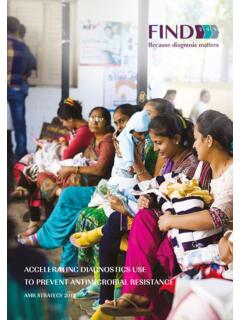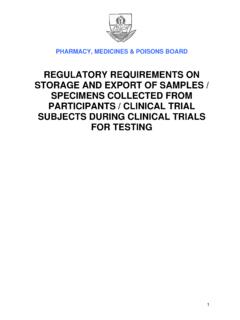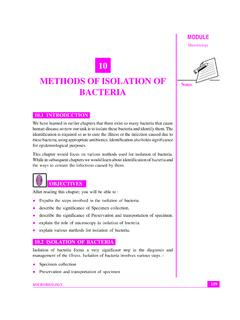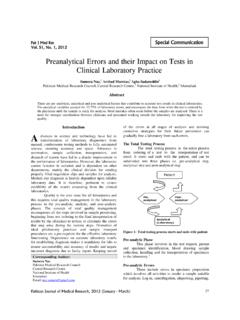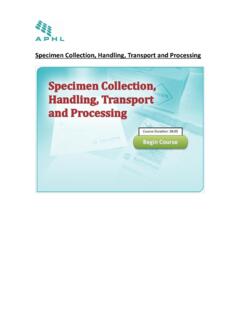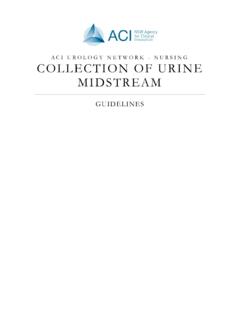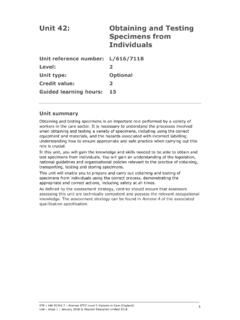Transcription of MGITTM Procedure Manual - FIND
1 Prepared for the Foundation for Innovative New Diagnostics MGIT TM. Procedure Manual For BACTEC MGIT 960 TB System (Also applicable for Manual MGIT). Mycobacteria Growth Indicator Tube (MGIT). Culture and Drug Susceptibility Demonstration Projects by Salman H. Siddiqi, (BD Fellow, Sparks, Maryland, USA ). and Sabine R sch-Gerdes, (Director, National Reference Center for Mycobacteria, Borstel, Germany). July 2006. TABLE OF CONTENTS. Section I: Principle of procedures A. Introduction B. Principle of the BACTEC MGIT 960 TB System 1. MGIT medium 2. Principle of detection and susceptibility testing Section II: Procedure for Primary Isolation A. Introduction B. Important Safety Precautions C. specimen Handling 1. collection 2. transportation 3. Storage D. Digestion, Decontamination and Concentration 1.
2 Sputum a. NaOH-NALC Procedure b. Other procedures c. Important points 2. Specimens other than sputum (extra-pulmonary). a. Pus and other mucopurulent specimens b. Gastric aspirates c. Bronchial washings d. Laryngeal swabs e. Tissue f. Urine g. Other body fluids E. Smears for Acid-Fast Bacteria (AFB). 1. Smear preparation 2. Staining methods a. Ziehl-Neelsen staining b. Kinyoun's staining c. Two-step staining d. Fluorochrome acid-fast staining 3. Microscopy 4. Reporting MGITTM Procedure Manual 3. TABLE OF CONTENTS. F. Preparation and Inoculation for Culture 1. Reagents a. MGIT medium b. MGIT growth supplement (enrichment). c. MGIT PANTA . 2. procedures a. Reconstituting PANTA. b. Inoculation of MGIT medium c. Inoculation of additional media d. Precautions e. Incubation f.
3 Detection of positive growth G. Work-up of Positive Cultures 1. AFB smear from a positive MGIT tube 2. Dealing with contamination a. Bacterial contamination b. Isolation of mycobacteria from contaminated or mixed cultures c. Isolation of mixed mycobacterial culture on Middlebrook Agar Plate d. Cross-contamination 3. Sub-culturing a positive MGIT tube 4. Identification of isolated mycobacteria H. Results / Reporting I. Performance Characteristics J. Limitations of the Procedure K. Quality Control 1. Quality control of AFB smear staining 2. Quality control (QC) testing of MGIT medium a. QC strains b. Preparation of culture suspension c. Preparation of dilutions d. Inoculation/incubation e. Expected results f. Precautions 3. Quality control of laboratory procedures a. Positive and negative controls b.
4 Quality control with laboratory data 4. Record keeping MGITTM Procedure Manual 4. TABLE OF CONTENTS. Section III: Drug Susceptibility Testing A. Primary Drug Susceptibility Testing (SIRE). 1. Introduction 2. Principles of the test 3. Reagents a. Drugs b. SIRE supplement c. Storage 4. procedures a. Reconstitution of lyophilized drugs b. Addition of a drug to the medium c. Preparation of the inoculum d. Inoculation and incubation 5. Testing at higher drug concentrations 6. Results 7. Reporting 8. Quality control (QC). B. Pyrazinamide (PZA) Susceptibility Testing 1. Introduction 2. Principles of the test 3. Reagents 4. procedures a. Reconstitution of lyophilized PZA drug b. Preparation of the inoculum c. Inoculation and incubation 5. Results 6. Reporting 7. Quality control C.
5 Secondline Drug Susceptibility Testing Section IV: References MGITTM Procedure Manual 5. TABLE OF CONTENTS. Section V: Appendices Appendix A: Supplies from Becton, Dickinson & Company (BD). 1. Supplies for culture work 2. Staining kits 3. Supplies for drug susceptibility testing Appendix B: Miscellaneous procedures and Information 1. Stains of mycobacteria commonly used 2. McFarland turbidity standard 3. AFB stains a. Ziehl-Neelsen stain b. Kinyoun's stain c. Auramine O fluorescent (fluorochrome) stain 4. Reagents for digestion decontamination a. NaOH NALC reagents b. Sodium hydroxide solution c. Phosphate buffer (pH , M). Appendix C: procedures for Troubleshooting 1. Decrease or no recovery of mycobacteria 2. Delay in the detection time 3. Guidelines to control high contamination 4.
6 Cross-contamination Appendix D: Guidelines for Susceptibility Testing 1. Initial start and evaluation of BACTEC MGIT 960 susceptibility testing a. Introduction b. Planning the evaluation c. Preparation of inoculum d. Addition of supplement into MGIT tubes e. Addition of drugs to the medium f. Addition of inoculum g. Loading MGIT tubes in the instrument h. Interpretation of results i. How to evaluate BACTEC MGIT 960 susceptibility results 2. Susceptibility testing and second line drugs MGITTM Procedure Manual 6. PREFACE. The purpose of this Procedure Manual is to provide additional procedures and comprehensive instructions which may not be included in the package inserts of the BACTEC MGIT . 960 System. These measures and instructions should help in starting a new liquid culture system in a laboratory, especially in developing countries.
7 This Procedure Manual provides guidelines for the BBL MGIT System, which is a Manual system, and for BACTEC. MGIT 960 TB System, which is an automatic instrument system. Because contamination of liquid media is a concern for new users, special emphasis is given and guidelines for contamination control have been provided in different sections of the Manual . Every laboratory using the Mycobacteria Growth Indicator Tube (MGIT ) System should keep this Manual readily available and should use this document as a reference for mycobacteriology procedures , particularly for the MGIT System. Optimal performance is achievable only if these procedures are strictly followed. Further changes in the Procedure or products, if needed, will be communicated with replacement pages which should be inserted into your copy of this Manual .
8 For further procedural details used conventionally in mycobacteriology laboratories, please refer to Clinical Microbiology Procedure Handbook (Section 7) and Public Health Mycobacteriology Level III Guide, CDC , 2. MGITTM Procedure Manual 7. MGITTM Procedure Manual 8. Section I: Principle of Procedure A. Introduction Demonstration of acid-fast bacilli (AFB) in a smear made from a clinical specimen provides a preliminary diagnosis of mycobacterial disease, while the isolation of mycobacteria on culture provides a definite diagnosis of tuberculosis or disease due to mycobacteria other than M. tuberculosis (MOTT bacilli) or non-tuberculous mycobacteria (NTM). As much as 50-60% of AFB culture-positive clinical specimens may fail to reveal AFB on smear made from the specimen .
9 As a consequence, culture techniques play a key role in the diagnosis of mycobacterial disease. Egg-based media, such as Lowenstein-Jensen (LJ) or Ogawa have been used for cultivation of mycobacteria for several decades. In 1958, Middlebrook and Cohn described an agar- based medium to permit more rapid detection of mycobacterial However, it still required an average of 3-4 weeks to recover mycobacteria from clinical specimens. In 1969, Deland and Wagner developed a technique for semi-automated detection of the metabolism of bacteria by measuring the 14CO2 liberated during the growth and decarboxylation of 14C-labeled substrate incorporated in the growth This radiometric technique was widely used for blood culture using the BACTEC 460 instrument. In 1980, this technique was introduced commercially for mycobacterial recovery from clinical specimens and drug susceptibility testing.
10 A large number of clinical trials were carried out to compare the radiometric BACTEC 460 TB System with solid media for primary isolation and drug susceptibility testing. Several evaluations of the BACTEC 460 TB. System published between 1980 and 1985 demonstrated excellent results with significant time savings,5,6,7, ,10 especially from smear negative The BACTEC 460 TB System has been reported to yield 15-20% increased culture positivity of clinical specimens as compared to conventional solid media such as LJ medium, with an average time-to-detection of positive growth from 8 to 14 days as compared to 3 to 5 weeks on solid media. The introduction of the BACTEC 460 TB System revolutionized laboratory testing for mycobacteria and has established itself as the gold standard for culture and susceptibility testing.
